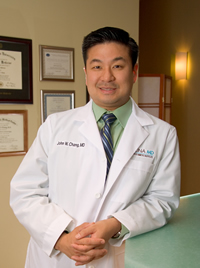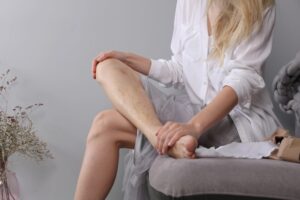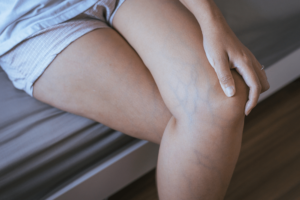Varicose veins of the legs are a common problem that particularly affects women. Small purple, blue or red veins can form anywhere on the leg, from the top of  the thigh to the ankle, remaining close to the surface of the skin.
the thigh to the ankle, remaining close to the surface of the skin.
Several factors can cause varicose veins, including heredity, pregnancy, weight, occupations or activities that require prolonged sitting or standing, and certain medications. Varicose veins are larger, darker in color and tend to bulge. Varicose veins are usually painful and related to more serious venous disorders.
Some of the causes of varicose veins can include:
Age. As you get older, your veins can lose elasticity causing them to stretch. The valves in your veins may become weak, allowing blood that should be moving toward your heart to flow backward. Blood pools in your veins, and your veins enlarge and become varicose. The veins appear blue because they contain deoxygenated blood, which is in the process of being recirculated through the lungs.
Pregnancy. Some pregnant women develop varicose veins. Pregnancy increases the volume of blood in your body, but decreases the flow of blood from your legs to your pelvis. This circulatory change is designed to support the growing fetus, but it can produce an unfortunate side effect — enlarged veins in your legs. Varicose veins may surface for the first time or may worsen during late pregnancy, when your uterus exerts greater pressure on the veins in your legs. Changes in your hormones during pregnancy also may play a role. Varicose veins that develop during pregnancy generally improve without medical treatment within three months after delivery.
Factors that increase the risk of developing varicose veins:
- Age. The risk of varicose veins increases with age. Aging causes wear and tear on the valves in your veins that help regulate blood flow. Eventually, that wear causes the valves to allow some blood to flow back into your veins where it collects instead of flowing up to your heart.
- Sex. Women are more likely to develop the condition. Hormonal changes during pregnancy, premenstruation or menopause may be a factor. Female hormones tend to relax vein walls. Taking hormone replacement therapy or birth control pills may increase your risk of varicose veins.
- Family history. If other family members had varicose veins, there’s a greater chance you will too.
- Obesity. Being overweight puts added pressure on your veins.
- Standing or sitting for long periods of time. Your blood doesn’t flow as well if you’re in the same position for long periods.
Signs and symptoms of varicose veins?
A sign is something everybody can detect, such as a rash or bloodshot eyes, while a symptom is something only the patient can feel and describe, such as pain or ringing in the ears.
In the majority of cases, there is no pain. Signs may include:
- Veins can be seen as twisted, swollen and lumpy (bulging); some people have described them as cords
- The veins are blue or dark purple
Some patients may also experience:
- The legs aching
- The legs feel heavy, especially after exercise or at night
- A minor injury to the affected area may result in longer bleeding than normal
- Lipodermatosclerosis – fat under the skin just above the ankle can become hard, resulting in the the skin shrinking
- Swollen ankles
- Telangiectasia in the affected leg (spider veins)
- There may be a shiny skin discoloration near the varicose veins, usually brownish or blue in color
- Venous eczema (stasis dermatitis) – the skin at the affected area is red, dry and itchy
- When suddenly standing up, some patients may experience leg cramps
- A high percentage of people with varicose veins also have restless legs syndrome
- Atrophie blanche – irregular whitish patches that look like scars appear at the ankles.
Varicose veins can appear in various parts of the body, including:
- Legs (most common)
- Rectum
- Pelvis
- Vagina
- Uterus (womb)
- Esophagus.
Diagnosing varicose veins
A physical examination, mainly visual, by a qualified doctor will decide whether or not a patient has varicose veins. The patient will be asked to stand while the doctor checks for signs of swelling. The patient may also be asked questions about the symptoms, whether any close relatives have/had varicose veins, and whether they are or have been pregnant. The physician may also ask the patient whether he/she has ever had any leg injury, such as a broken bone, and any history of deep vein thrombosis.
In some cases, a general practitioner (GP, primary care physician, family doctor) may refer the patient to a vascular specialist.
The following diagnostic tests may also be ordered:
- Doppler test – this is an ultrasound scan to check the direction of blood flow in the veins to see whether the valves are working properly. This test can also check for blood clots or obstructions in the veins.
- Color duplex ultrasound scan – this ultrasound test provides color images of the structure of veins, which helps the doctor identify any abnormalities. This test can also measure blood-flow speed.

John W. Dr. Chang, MD, serves as the Partner and Medical Director at Miami Vein Institute, a premier center specializing in vein treatment in South Florida. With a focus on providing high-quality care and ensuring patient safety and satisfaction, Dr. Chang has helped establish Miami Vein Institute as a leading destination for minimally invasive vein treatments. At Miami Vein Institute, Dr. Chang offers a comprehensive range of minimally invasive procedures, including Endovenous Laser Treatments (EVLT) and Sclerotherapy, to address various vein-related concerns. His expertise in both general and cosmetic surgery, combined with specialized training in vein treatments, allows him to tailor treatment plans to meet each patient’s individual needs. Dr. Chang’s commitment to excellence is reflected in his meticulous attention to detail and dedication to staying updated with the latest advancements in vein care technologies. He is certified in a wide array of cosmetic surgery procedures and is a certified trainer for various advanced techniques. Dr. Chang’s affiliations with prestigious medical associations underscore his commitment to upholding the highest standards of medical excellence. With a focus on patient well-being and personalized care, Dr. Chang ensures that every patient receives honest, expert guidance throughout their treatment journey. His passion for providing the best possible care is evident in his commitment to patient satisfaction and achieving optimal outcomes.

